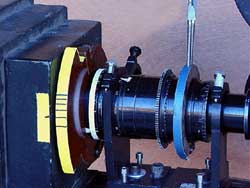Zoom Lens Tricks
If a zoom lens can be extended out of it's mount with an extension tube, unscrewed
and/or held with matte box rods the lens will now focus closer than minimum
focus as you zoom wider. This is useful for shooting tabletop thing like chemistry
glassware. Calculate the lens extension exposure increase for the maximum focal
length of the lens which is usually negligible. Macro zoom lenses do this same
effect, but not with as much control. ALMOST ALL "MACRO" ZOOMS DO NOT ZOOM IN
THE MACRO POSITION.
If a camera is on a Dutch Head or rotating head, you can hold the zoom ring
stationary and get a spinning zoom effect as you spin the camera. It isn't easy
hand held except to zoom out with a lighter 16 mm camera.
Nets and gauze can be placed at the rear of the lens for diffused effects. Light
on gauzes, nylon stockings and fabric diffusion in front of the lens can increase
exposure and change the amount of diffusion. Behind the lens they do not. Fabric
does not effect the flange focal distance as glass or plastic filters behind
the lens do. In the rear they seem to have a more consistent effect than filters
in front of a zoom lens at different focal lengths.
I have found that I get LESS diffusion effect on film than I see on Arri ground
glasses. Some tests are in order. Shooting white wolves in the snow we found
seeing focus with a heavy fog filter was very difficult. We made marks without
the filters and trusted the wolves to follow the same route from cage to cage.
Expanding the focus ring diameter with a clamp-on disks makes it easier for
assistants to make marks. If painted white they can be written on. An adjustable
clamp-on zoom handle is also handy. Turn one on a lathe to the lens zoom ring
outer diameter. Cut in half and hinge with a chain link and add two handles
that can be taped together so it holds. It is also useful as a solid zoom stop
by the operator. A third finger can warn when the stop is about to be hit and
the operator knows to slow to a stop.
We made matte boxes out of aluminum radio chassis boxes for years before all
the fancy stuff available today. Tapering sizes of boxes can be attached to
one another by bending aluminum tabs into progressively smaller boxes closer
to the lens. You can't use 6 layers of diffusion and grads on these, but they
are cheap and very effective. Use flat or crinkle black paint and black flock
paper to block internal reflections.
Radio chassis boxes and some imagination will make a very serviceable matte
box. Also look at 4 X 5 Graflex Camera bellows. Often, camera repair people
have rejects with pin holes that are serviceable.
Zoom lenses can be extended at a loss of sharpness and F-stop. You are only
using the center image of the lens with an extender. Before the 150-600 mm Canon
we had nothing else as a long zoom. Still zooms can be extended with extenders
modified with a movie mount on the back. The Canon and Nikon 50-300 Zooms aren't
bad. Century Precision Optics can modify the Canon to a universal mount. (Ask
about the Nikon.) The Canon "shifts" zoom speed part way through the range.
Arri II's can be modified to a Nikon mount, but not a Canon mount. Rack over
Mitchells and Eymos can be modified to almost any mount.
An advantage to the Nikon and Canon zooms is they can use the Cokin Pro size
filters. Cokin Pro filters can also be used at longer focal lengths on regular
zooms. Making a holder to center the Cokin lens shade with the center of the
lens works. This can be supported on the matte box rods. A lens cap made from
a jar lid and taped to size will work on non rotating front element zoom lenses.
We also modified 12-120 Angenieux 16 mm lenses to focus in the macro range by
removing the front element group and replacing it with an older 55 mm f 1.2
Nikkor removed from its mount. We extended the lens with Birns and Sawyer 2
x (actually 2.2 x) extender to cover 35 mm. The combination had to be stopped
down to get a quality image. The same extender works with the 12 to 240 Angenieux
for a 20 to 1 zoom. Removing the front element of the 9.5 to 57 mm Angenieux
also gave a pretty sharp macro zoom that is extendible. Other Cooke and Zeiss
16 mm zooms are extendible. All of these modifications need good support to
the matte box rods or some other means.
We used Nikkor lenses for hard lenses for years. The problem is that they focus
in the opposite direction as movie lenses. They were cheaper and fine for crash
cameras.
© Copyright 1999-2004 Ron Dexter. All Rights Reserved.





